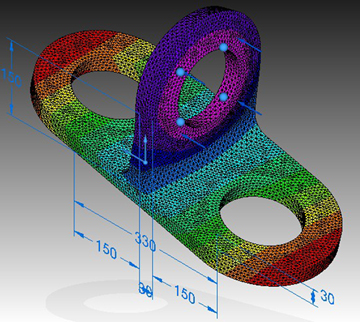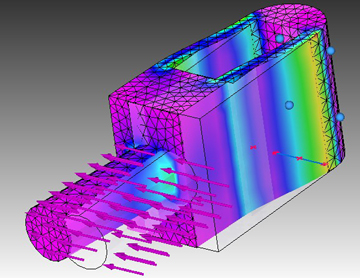March 20, 2010

In the last few days, I acquired a taste for destruction. I blame it on Solid Edge with Synchronous Technology 2 (SE with ST2).
After exploring part modeling, I ventured into the Simulation tab to see what kind of virtual mayhem I might cause. I’ll tell you, there’s nothing quite like watching a metal plate or a steel ring get twisted and deformed right before your eyes—in full color, in 3D, in slow motion, available for rewind (you can watch some of them in the video clip below).
Today, most mid-range and high-end mechanical modelers give you some basic analysis tools, so it’s no surprise to find them in SE with ST2, the second release of Siemens’ hybrid (parametric-direct) CAD package. The advantage of using a direct modeler—one that lets you push and pull faces to reshape your geometry on the fly—is what you can do before and after an analysis session.
Two of the most computation-intensive operations in analysis are meshing (subdividing the model into tiny chunks) and solving (calculating the effects of the applied forces, load, pressure, and temperature on your model). To minimize your CPU’s workload, you could remove unimportant details such as ribs, rounds, and holes from your parts. Stripping your model down to basic (primitive) shapes reduces the volume of geometry the software needs to deal with, so the process goes a lot faster.
With history-based parametric modelers, deleting blends, rounds, holes, and bosses could cause regeneration failure, because the software may not be able to cope with missing historical steps. By contrast, in a direct modeler like SE with ST, such drastic edits come easily because history is not the be-all and end-all. Similarly, after your analysis, if you need to strengthen your part, SE with ST2 lets you add materials, thicken walls, and shrink holes with just a few mouse clicks.

Slide and Rotate
In setting up your analysis, aside from the usual fixed option (which means to treat a surface or a feature as though it’s bolted to a stationary position), you may also specify the part to slide along a surface or rotate around an axis. These options let you study parts that might move up and down or pivot on a pole under stress.
In applying forces, you have the option to specify the size, density, and color of the arrows displayed. This feature may not make a difference if you’re dealing with a single force or load, but if you happen to have multiple sources of impact, you could customize the arrows to signify the relative importance (or severity) or each force.
Along with a linear force, you may also apply temperature, gravity, or centrifugal force on your model. In applying forces on curved regions (such as blended corners or arc-shaped faces), SE with ST2’s cartwheel pointer makes it easy to specify the exact direction of the force.
Analysis results can be exported as HTML reports, AVI movies, or JPEG images (a few of them are used here to illustrate the blog post). PDF and Word output options are in development, according to Siemens. You may also probe on specific nodes (selectable points in the model) to obtain numeric values of their impact.
SE with ST2’s simulation functions are powered by NX Nastran, Siemens’ premiere finite element analysis package. SE with ST2 is available as part of Siemens’ Velocity Series, targeted at mid-size firms and businesses.
For more, read Part I of the series, “First Encounter” (March 2, 20110). To watch animation clips of analysis results, visit DE Exchange and search for videos tagged SE with ST2.
The video clip below demonstrates the analysis features discussed in this post:
Subscribe to our FREE magazine, FREE email newsletters or both!
About the Author
Kenneth Wong is Digital Engineering’s resident blogger and senior editor. Email him at [email protected] or share your thoughts on this article at digitaleng.news/facebook.
Follow DE





